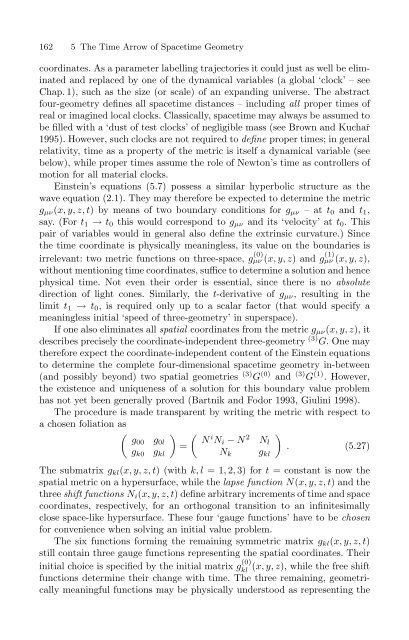The Physical Basis of The Direction of Time (The Frontiers ...
The Physical Basis of The Direction of Time (The Frontiers ...
The Physical Basis of The Direction of Time (The Frontiers ...
Create successful ePaper yourself
Turn your PDF publications into a flip-book with our unique Google optimized e-Paper software.
162 5 <strong>The</strong> <strong>Time</strong> Arrow <strong>of</strong> Spacetime Geometry<br />
coordinates. As a parameter labelling trajectories it could just as well be eliminated<br />
and replaced by one <strong>of</strong> the dynamical variables (a global ‘clock’ – see<br />
Chap. 1), such as the size (or scale) <strong>of</strong> an expanding universe. <strong>The</strong> abstract<br />
four-geometry defines all spacetime distances – including all proper times <strong>of</strong><br />
real or imagined local clocks. Classically, spacetime may always be assumed to<br />
be filled with a ‘dust <strong>of</strong> test clocks’ <strong>of</strong> negligible mass (see Brown and Kuchař<br />
1995). However, such clocks are not required to define proper times; in general<br />
relativity, time as a property <strong>of</strong> the metric is itself a dynamical variable (see<br />
below), while proper times assume the role <strong>of</strong> Newton’s time as controllers <strong>of</strong><br />
motion for all material clocks.<br />
Einstein’s equations (5.7) possess a similar hyperbolic structure as the<br />
wave equation (2.1). <strong>The</strong>y may therefore be expected to determine the metric<br />
g µν (x, y, z, t) by means <strong>of</strong> two boundary conditions for g µν –att 0 and t 1 ,<br />
say. (For t 1 → t 0 this would correspond to g µν and its ‘velocity’ at t 0 .This<br />
pair <strong>of</strong> variables would in general also define the extrinsic curvature.) Since<br />
the time coordinate is physically meaningless, its value on the boundaries is<br />
irrelevant: two metric functions on three-space, g µν (0) (x, y, z) andg µν (1) (x, y, z),<br />
without mentioning time coordinates, suffice to determine a solution and hence<br />
physical time. Not even their order is essential, since there is no absolute<br />
direction <strong>of</strong> light cones. Similarly, the t-derivative <strong>of</strong> g µν , resulting in the<br />
limit t 1 → t 0 , is required only up to a scalar factor (that would specify a<br />
meaningless initial ‘speed <strong>of</strong> three-geometry’ in superspace).<br />
If one also eliminates all spatial coordinates from the metric g µν (x, y, z), it<br />
describes precisely the coordinate-independent three-geometry (3) G.Onemay<br />
therefore expect the coordinate-independent content <strong>of</strong> the Einstein equations<br />
to determine the complete four-dimensional spacetime geometry in-between<br />
(and possibly beyond) two spatial geometries (3) G (0) and (3) G (1) . However,<br />
the existence and uniqueness <strong>of</strong> a solution for this boundary value problem<br />
has not yet been generally proved (Bartnik and Fodor 1993, Giulini 1998).<br />
<strong>The</strong> procedure is made transparent by writing the metric with respect to<br />
a chosen foliation as<br />
(<br />
g00<br />
)<br />
g 0l<br />
=<br />
g k0 g kl<br />
( )<br />
N i N i − N 2 N l<br />
. (5.27)<br />
N k g kl<br />
<strong>The</strong> submatrix g kl (x, y, z, t) (withk, l =1, 2, 3) for t = constant is now the<br />
spatial metric on a hypersurface, while the lapse function N(x, y, z, t) and the<br />
three shift functions N i (x, y, z, t) define arbitrary increments <strong>of</strong> time and space<br />
coordinates, respectively, for an orthogonal transition to an infinitesimally<br />
close space-like hypersurface. <strong>The</strong>se four ‘gauge functions’ have to be chosen<br />
for convenience when solving an initial value problem.<br />
<strong>The</strong> six functions forming the remaining symmetric matrix g kl (x, y, z, t)<br />
still contain three gauge functions representing the spatial coordinates. <strong>The</strong>ir<br />
initial choice is specified by the initial matrix g (0)<br />
kl<br />
(x, y, z), while the free shift<br />
functions determine their change with time. <strong>The</strong> three remaining, geometrically<br />
meaningful functions may be physically understood as representing the



![arXiv:1001.0993v1 [hep-ph] 6 Jan 2010](https://img.yumpu.com/51282177/1/190x245/arxiv10010993v1-hep-ph-6-jan-2010.jpg?quality=85)


![arXiv:1008.3907v2 [astro-ph.CO] 1 Nov 2011](https://img.yumpu.com/48909562/1/190x245/arxiv10083907v2-astro-phco-1-nov-2011.jpg?quality=85)








![arXiv:1002.4928v1 [gr-qc] 26 Feb 2010](https://img.yumpu.com/41209516/1/190x245/arxiv10024928v1-gr-qc-26-feb-2010.jpg?quality=85)
![arXiv:1206.2653v1 [astro-ph.CO] 12 Jun 2012](https://img.yumpu.com/39510078/1/190x245/arxiv12062653v1-astro-phco-12-jun-2012.jpg?quality=85)
